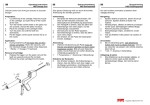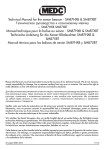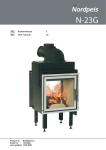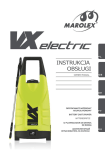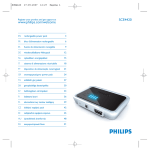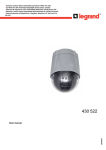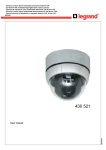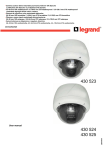Download Krøger
Transcript
Krøger - B600 GB DE FR DK FI RU Battery Operated Caulking Gun / Operating and Safety Instructions Batterie Fugenpistole / Bedienungs- und Sicherheitshinweise Pistolet d’étanchéité à batterie / Mode d’emploi et instructions de sécurité Batteri fugepistol / Betjenings- og sikkerhedsvejledning Akkutoiminen saumauspistooli / Käyttö- ja turvallisuusohjeet Аккумуляторный пистолет для заделки швовИнструкции по эксплуатации и безопасности ES Pistola de calafatear a pilas / Instrucciones de funcionamiento y de seguridad PL Pistolet do mas uszczelniających z napędem bateryjnym / Instrukcja obsługi i bezpieczeństwa IT JP Pistola per sigillanti a batteria / Istruzioni per l’uso e di sicurezza バッテリー式コーキング・ガン / 操作および安全上の注意 / GB TABLE OF CONTENTS Technical specifications - General data - International norms and standards How to use the caulking gun? Drawing of complete gun and charger General safety instructions Use and maintenance TECHNICAL SPECIFICATIONS Weight: approx. 2 kilos (incl. battery) Length (incl. barrel 600 ml): approx. 525 mm Power (impact of piston): 2.5 kN(250 kilos) Speed (piston rod): up till 10 mm/sec Battery capacity: 10.8V / 1.1Ah (Li-Ion) Charger: Battery recharging time: max. 45 min (80% charged after approx. 25 min.) (It is recommended that the battery is pulse-charged, and not necessarily drained each time) Manufactured according to international standards: CE 220V (110V) Operations per charging: approx. 30 tubes (600 ml) approx. 50 cartridges (310 ml) (dependent on viscosity and temperature) DRAWING OF COMPLETE GUN AND CHARGER Residue-level indicator (6) 6 Indicator position when 400 ml and 600 ml barrels are full 7 11 Indicator position when 400 ml barrel is empty Indicator position when 600 ml barrel is empty 2 Indicator position, if it is desirable to stop the ”recoil” to empty 310 ml cartridges or 400 ml tubes in 600 ml barrel 1 8 3 10 4 5 Charger The diode will show constant green light when the battery is charged between 80% and 100%. The battery is ready for use. The diode will show constant red light if the battery is too hot , or too cold (< 0 ºC). Charging will start when the battery is sufficiently cooled or heated. The diode will show blinking red light if the battery is defective. Replace the battery with a new one. The diode will show blinking green light when the battery charging is in progress and running without problems. 2 GB / HOW TO USE THE CAULKING GUN? The gun is active when the trigger (1) is activated (diode is green). The piston is quickly driven forward to the starting position, then the driving speed is adjusted to the user’s settings. The piston (8) is driven slightly backwards when the trigger (1) is released (ensures minimal reflux). When the gun is active (diode is green), the return button (2) is pressed and held for at least 2 seconds (gear shall engage), then it is fully returned. The piston (8) is driven all the way back and stops automatically (if full return is interrupted, the trigger (1) is activated and the piston (8) is driven forward again). If not in use, the gun will close down automatically after 20 seconds (ensures that the battery is not drained during the standby period). The speed regulator wheel (3) can be easily operated by using the ring or little finger simultaneously with the index finger activating the trigger (1). This allows for easy adjustment of speed during work. Charging: when the charger is blinking green the battery is at least 80% charged, the battery will endure pulse-charging – see description page 2 Residue-level indicator (6) - see description page 2 Battery indicator (5) indicates the amount of power left in the battery: Constantly showing green light > 50% Shifting between red/green > 20% Constantly showing red light< 20% (charge or replace battery) (red/green blink = the gun is overloaded) The white tube piston (8) is easily clicked off and on when changing from tube to cartridge or for replacement. When the white tube piston is clicked off, cartridges may be used for caulking – see instruction page 4 The barrel (9) is threaded, and is easily unscrewed for cleaning or changing to shorter barrel (e.g. 310 ml cartridge or 400 ml tube). Important! It is recommended to use a short barrel when using 310 ml cartridges The end cap (10) is threaded and will fit most jets. The battery (4) is removed from the gun by applying gentle pressure to both sides of the battery, and it may then be pulled out. . Replacement of the protective cuff (11) - see instruction page 4 USE AND MAINTENANCE CAUTION! IMPORTANT! Always remove the battery prior to cleaning the gun. Wipe off the tool with a dry, soft cloth. When the gun is blinking red/green light, it indicates that it is overloaded (continued use at red/green blinks will reduce the working life of the gun considerably) Do not use a wet cloth or solvents, because this may harm and discolour the gun. The gun (the butt-end itself) must NOT be opened or taken apart Inspect and clean the gun at regular intervals Piston rod joints must NOT be taken apart or broken Recharge the battery at least every six months The protective cuff (8) must NOT be removed from the gun, but may be replaced Oil the interior of the cylinder before use. ONLY use original parts Do NOT expose the gun to rain or moisture The guarantee will be void if the above mentioned points are not observed 3 / GB USE AND MAINTENANCE IMPORTANT! The warranty is void if the gun is used without the protective cuff, and if this results in joint filler getting onto the piston rod. The gun must NOT be used with a nozzle in which joint filler has set or hardened. The nozzle must then be replaced or cleaned of the set or hardened joint filler. The nozzle size must be at least 3.5mm – see instruction page 5. Contact the dealer where you bought the gun if repair is necessary. USE AND MAINTENANCE REPLACEMENT OF PROTECTIVE CUFF 1. Pull the cuff backwards over the piston rod 2. Reveal the toothed bar, and unscrew the screw. 3. Pull off the piston joint, and then the cuff may be pulled off the piston rod 4. Push down the new cuff along the piston rod, and reassemble the piston joint by pushing it into place on the piston rod and tighten the screw. 5. Put the protective cuff in place by pushing it towards the piston as shown. Check that it is fitted tightly. REPLACEMENT OF PISTON (TUBE/CARTRIDGE) 3. The tube piston can be clicked on and off when the piston rod is fully returned 1. When the gun is used for cartridges the tube piston should not be fitted 2. The tube piston is clicked off the piston joint as shown in the picture. When the gun is used for tubes, the tube piston must be fitted 4 GB / USE AND MAINTENANCE Smallest nozzle size: 3.5mm –4mm NOZZLE SIZE: To ensure problem-free caulking, it is recommended that the nozzle size is as big as possible. If caulking is done with a smaller nozzle size, the speed of the gun should be adjusted down to ensure a) that the cartridge/tube does not leak or break, and b) that the gun is not overloaded. For further reference please see the chapter: ”How to use the gun/the speed regulator wheel/battery indicator. GENERAL SAFETY INSTRUCTIONS Read all safety instructions before you start using the tool, and store them in your files after you have finished reading. FOR SAFE USE: WARNING: When using cordless tools, the following basic safety regulations must always be followed to minimize the risk of fire, leaking batteries and personal injuries: Keep the work site clean. An untidy working area may easily lead to personal injuries. Create a good working environment. Do not expose the electric tool to rain. Do not use the electric tool in damp or wet places. Always make sure that the work site is well lit. WARNING: Do not use the electric tool in the proximity of flammable liquids or gas. Avoid electric shock. Avoid physical contact with earthed implements, e.g. pipes, radiators, stoves, and refrigerators. Keep children away. Do not allow unauthorized persons to come in contact with tools or extension wires. Make sure that no unauthorized persons are present at the work site. Always return the tool and the battery to their proper place after use. When the tool and the battery are not in use, they must be individually stored in a dry place, which is elevated or locked – out of children’s reach. Make sure that the battery’s poles are not short-circuited by metal parts, for instance screws, nails etc. Do not overload the tool. It will perform better and with greater safety at the intended ratio. Use the right tool. Do not use a smaller tool or accessories for a job requiring a heavier tool. Never use a tool for a job it is not intended for. Use safety goggles. Also use facial or dust mask if necessary. Keep the tool in good condition. Keep the tool clean; this will make the work safer. Follow the instructions regarding lubrication and replacement of accessories. Make sure that the handles are dry, clean, and free from oil and grease. Unplug tool/batteries when the tool is not in use, i.e. before repair and while changing accessories such as piston and barrel. Check damaged parts. If the protective cuff or another part is damaged, it must be thoroughly checked to ascertain whether it will function properly and as intended. Check whether the movable parts are in the correct position, whether the movable parts can move freely, whether the parts are intact, whether the assembly is correctly done, as well as whether other conditions influencing the tool’s functions are in order. A piston or another part that has been damaged shall be repaired according to regulations or replaced by an authorized dealer, unless otherwise indicated in these safety regulations. Make sure that defective switches are replaced by an authorized supplier. Never use the tool if it cannot be started and stopped with the switch. 5 / GB GENERAL SAFETY INSTRUCTIONS Warning: Use of accessories or equipment other than those recommended in this user manual may entail a risk of personal injury. Make sure to use only original batteries meant for use with the tool. Before connecting the charger, make sure that the surfaces of the battery or the tool are clean and dry. Make sure that the batteries are charged with original MK parts. Incorrect use may entail a risk of electric shock, superheating or leakage of corrosive liquids from the battery. Unplug the charger by pulling at the plug instead of at the wire itself. This will minimize the risk of damaging the plug as well as the wire. Have the tool repaired by a qualified professional. This power-tool fulfils the requirements of the relevant safety regulations. Repair should only be carried out by qualified persons, and only original spare parts should be used. Failure to comply with the aforementioned safety regulations may constitute a serious risk of injury for the user of the tool. Do not take the charger apart. If it needs checking or repair, deliver it to a qualified repair shop. If it is incorrectly reassembled it may result in a risk of electric shock and/or fire. Disposal of battery: Make sure that the battery is disposed of in a safe manner and in accordance with national regulations. Check that the wire lies in such a way as to prevent anyone to step on it, trip over it, or in other ways subject it to damage or pressure. Avoid contact with liquid from the battery. Should any person by mistake come in contact with the liquid, it is necessary to rinse with clean water. If liquid gets into a person’s eye, seek medical help immediately. The charger and the battery are specially made to work together. Avoid charging other cordless tools or batteries with this charger. Avoid charging the battery with other chargers. BATTERY CHARGER & BATTERY PACK Avoid separating the battery charger and the battery itself. Save these safety instructions. This user manual contains important safety instructions for the battery charger. Read all safety instructions and warnings concerning the battery charger and the battery pack before you start using the battery charger. WARNING: only charge battery of the correct type. Other types of batteries may explode and cause personal injuries and other damages. Do not subject the charger to rain or snow, and avoid using it in damp places. The use of non-recommended spare parts may constitute a risk of fire, electric shock, and/or personal injury. 6 Do not use the charger if the wire or plug are damaged – replace them as soon as possible. Do not use the charger if it has been subject to a heavy blow, has fallen down on the floor, or in any other way has been damaged – deliver it to a qualified repair shop. To minimize the risk of electric shock, the charger must be unplugged before it is subject to maintenance or cleaning. Do not put the tool and the battery pack in a place where the temperature may exceed 50° C (e.g. a metal tool shed or a car in the summer). This may cause deterioration of the battery’s capacity and damage to the battery. Do not charge the battery if the temperature is below 0°C or over 40°C. Do not burn the battery as it may explode. The charger is made for use with a regular electricity network. Only charge the voltage indicated on the name plate. Avoid using any other voltage value. Handle the wire with care. The charger must never be carried by the wire or unplugged with a vigorous pull. Keep the wire at a good distance from heat, oil, and sharp edges. GB / GENERAL SAFETY INSTRUCTIONS Charge the battery pack in a well-ventilated place. Do not cover the charger and the battery pack with a cloth or similar during the charging process. Avoid short-circuiting the battery. Short-circuiting may constitute heavy loss of effect, superheating, and fire. NOTE: If the power supply wire of this component has been damaged it must be replaced by a service personnel authorized by the manufacturer, because special tools must be used. WARNING: If leakage of electrolytic liquid occurs, rinse with water/ a neutralizing agent. If the liquid has come in contact with the eyes, seek medical aid immediately. The device is not meant to be used by children or impaired persons without supervision. Small children should be supervised to ensure that they do not play with the device. 7







